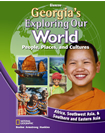

Georgia's Exploring Our World: Africa, Southwest Asia, and Southern and Eastern Asia © 2012Chapter 9: Southern and Eastern Asia TodayChapter OverviewsThe region of Southern and Eastern Asia has experienced economic growth since the late 1900s. Many of the region's countries, including China, have become important trading partners with the United States and other nations. China's government is controlled by the Chinese Communist Party. Although China's leaders have begun to allow people more economic freedom, such as choosing jobs they want, the government still keeps tight control over political activities. Cities are growing rapidly as people leave small villages in hopes of finding better-paying jobs. China's economy is growing as a result of the reforms, although rapid industrialization has caused serious air and water pollution. China's neighbors, Taiwan and Mongolia, have been influenced by their nearness to China. Taiwan has a strong industrial economy despite tensions with China over its independence. Taiwan also has a highly educated workforce and is moving toward democracy. Mongolia's economy relies on products from herd animals such as sheep, goats, cattle, and horses. In the 1990s, Mongolia abandoned its Communist system of government. Japan, a collection of four large islands and thousands of smaller ones, lies off the coast of Eastern Asia. Its government is a constitutional monarchy without a large military, but Japan is a strong world economic power. Japan's economy is industrial. It produces cars, ships, cameras, and consumer electronics, among other products. However, it faces growing competition from other countries in the region, and has an aging population that will result in a smaller workforce. Because of Japan's geography and limited amounts of land, people are crowded into urban areas. Lack of farmland means that Japan must import more than half its food supply. Daily life is a mix of traditional and modern ways. Clothing, art, and architecture reflect the traditions of the country as well as the influence of Western ideas. North and South Korea lie on the same peninsula but are very different countries. North Korea has a Communist government as a result of its occupation by the Soviet Union after World War II. In the 1950s, North Korea unsuccessfully attacked South Korea to bring it under Communist rule. The United States helped South Korea in this war. After the Korean War, South Korea's leaders rebuilt and industrialized the economy. South Korea is now an economic leader and a player in world affairs. In contrast, North Korea's leaders have isolated the country from the rest of the world. The Communist leaders devote most resources to the military and do not develop industry. North Korea's government controls its people's political, economic, and social lives, and poverty is widespread. Mainland Southeast Asia is a mix of stronger and weaker economies. Countries like Myanmar, Thailand, Malaysia, and Singapore have developed industry and have seen economic growth. Myanmar is a socialist country that exports wood products, gas, rice, and beans. Thailand benefits from tourism and some exports. Malaysia, on the southern end of the Malay Peninsula and the island of Borneo, exports raw materials and goods such as electronics and cars. Singapore, on the southern tip of the Malay Peninsula, is one of the world's most productive economies, and its people enjoy a high standard of living. Other Southeastern Asia countries, such as Laos and Cambodia, have weaker economies. Vietnam's Communist policies restrict economic growth. The islands of Southeast Asia have economies that rely on natural resources and agriculture. Indonesia and Brunei have oil and gas reserves, while the people of East Timor live by farming. The Philippines exports rice, sugarcane, bananas, and other agricultural products. Southern Asia's largest country, India, is the world's most populous democracy. It is a vast country with a diverse population, though the majority of its people are Hindu. India has a stable government and a growing economy. Like the United States, India is a federal republic with an elected president, although executive power lies with the prime minister. India's detailed constitution gives citizens many rights and also certain duties, which include promoting harmony among ethnic groups. The country's free market economy is growing rapidly, but because of its large population, there are not enough jobs. Agriculture is still an important economic activity, and there are factories and cottages industries. India's service sector is growing rapidly. Many U.S. companies outsource work to India because of its well-educated workers and because wages are low. India's neighbor, Pakistan, is also one of the world's most populous nations. Almost all its people are Muslim, and about half are farmers. Cotton cloth and clothing are major exports, and manufacturing and service industries are also important. Like India, Pakistan is a federal republic, but its democracy is more limited. Surrounded on three sides by India, Bangladesh is a densely populated country on the Bay of Bengal. Most people are poor and earn a living by farming. Rice is an important crop, and clothing is becoming a thriving industry. |  |















